Related Research Articles
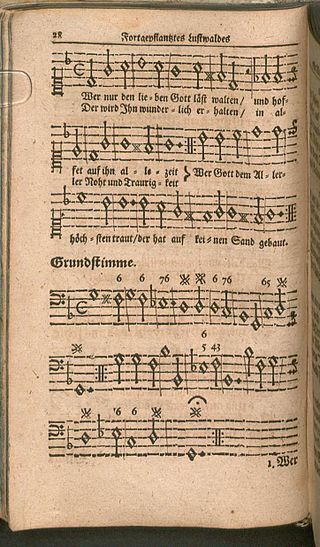
"Wer nur den lieben Gott läßt walten" is a 1641 hymn by Georg Neumark, who also composed the melody for it. It has seven verses and deals with the Christian putting their trust in God. Its author referred to it as a "Trostlied" or song of consolation and it first appeared in his Fortgepflantzer musikalisch-poetischer Lustwald. It also appeared in Johann Crüger's 1672 Praxis pietatis melica and in the first part of Johann Anastasius Freylinghausen's 1704 Geistreiches Gesangbuch. It has inspired musical settings, and is part of current German hymnals, both Protestant and Catholic.

Nikolaus Herman was a German Lutheran cantor and teacher, creating numerous Protestant hymns. Some of them are contained in hymnals in several languages.

"O Lamm Gottes, unschuldig" is an early Lutheran hymn, with text and melody attributed to Nikolaus Decius. Originally intended as a German version of the Latin Agnus Dei, it was instead used as a Passion hymn. In both contexts, the hymn has often been set to music, prominently as the cantus firmus in the opening chorus of Bach's St. Matthew Passion. It is included in most German hymnals, and has been translated by Catherine Winkworth, among others.

"Gott sei gelobet und gebenedeiet" is a Lutheran hymn of 1524 with words written by Martin Luther who used an older first stanza and melody. It is a song of thanks after communion. Luther's version in three stanzas was printed in the Erfurt Enchiridion of 1524 and in Johann Walter's choral hymnal Eyn geystlich Gesangk Buchleyn the same year. Today, the song appears in German hymnals, including both the Protestant Evangelisches Gesangbuch, and in a different version in the Catholic Gotteslob.

"Christe, du Lamm Gottes" is a Lutheran hymn, often referred to as the German Agnus Dei. Martin Luther wrote the words of the hymn as a translation of the Latin Agnus Dei from the liturgy of the mass. The tune, Zahn 58, was taken from an older liturgy. The hymn was first published in 1528 and has been the basis for several musical settings by composers such as Bach, Mendelssohn and Hessenberg. It appears in modern German hymnals, both the Protestant Evangelisches Gesangbuch and the Catholic Gotteslob.
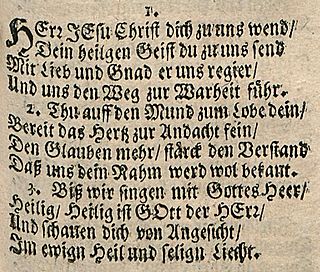
"Herr Jesu Christ, dich zu uns wend" is a Lutheran hymn from the 17th century. Its hymn tune, Zahn No. 624, was adopted in several compositions. It was translated into English and is part of modern hymnals, both Protestant and Catholic.

"Allein Gott in der Höh sei Ehr" is an early Lutheran hymn, with text and melody attributed to Nikolaus Decius. With the reformers intending church service in German, it was intended as a German version of the Gloria part of the Latin mass, used in almost every service. Decius wrote three stanzas, probably in 1523, while a fourth was added, probably by Joachim Slüter.

"In dich hab ich gehoffet, Herr" is a Lutheran hymn in seven stanzas, written by Adam Reusner and first published in 1533. He paraphrased the beginning of Psalm 31. It was first sung to the melody of a Passion hymn. The melody connected with the hymn in 1560 was derived from models dating back to the 14th century. A third melody from 1608 became a hymn tune for several other songs and translations to English. In the German Protestant hymnal Evangelisches Gesangbuch, the hymn appears as EG 257 with the second melody. Johann Sebastian Bach used the second and third melodies in chorale preludes, and the third also in cantatas and the St Matthew Passion.

"Was mein Gott will, das g'scheh allzeit" is a Lutheran hymn in German. The text from c. 1550 is attributed to Albert, Duke of Prussia. The melody, Zahn No. 7568, goes back to a tune by Claudin de Sermisy, written in 1529 for a secular French song. The hymn has belonged to core Lutheran hymnody without interruption and is part of the Protestant hymnal Evangelisches Gesangbuch as EG 364.
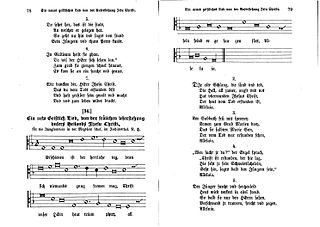
"Erschienen ist der herrlich Tag" is a German Easter hymn, with text and tune written by Nikolaus Herman and published in 1561. It has inspired musical settings by composers from the 17th to the 20th century. It appears in several hymnals, including the German Protestant hymnal Evangelisches Gesangbuch. Other hymns, especially Easter hymns, in both German and English, are sung to the same melody.

"Nun danket all und bringet Ehr" is a German Lutheran hymn in nine stanzas, with a text written by Paul Gerhardt. It was first published in 1647, in Johann Crüger's Praxis pietatis melica which was the first publication of hymns by Gerhardt. In the 1653 edition, Crüger added a melody that he composed. As a general song of thanks, the song has appeared in several hymnals, including the German Protestant hymnal Evangelisches Gesangbuch and the Catholic hymnal Gotteslob. It has inspired musical settings by composers from the 17th to the 21st century. Johann Sebastian Bach used the first stanza in a cantata, however with the melody of "Lobt Gott, ihr Christen alle gleich", Hugo Distler composed a chorale cantata, and Günter Berger based a toccata for organ on it.
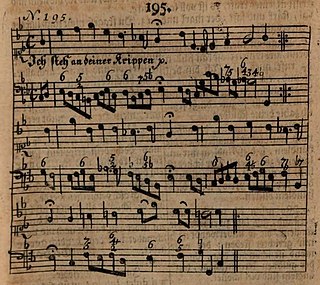
"Ich steh an deiner Krippen hier" is a German Christmas hymn, with lyrics by Paul Gerhardt which were first published in 1653. It was then sung with an older melody by Martin Luther, but a melody which was likely created by Johann Sebastian Bach for Schemellis Gesangbuch of 1736 is now part of current Protestant and Catholic hymnals.
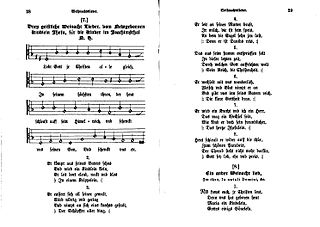
"Lobt Gott, ihr Christen alle gleich" is a German Christmas carol with lyrics and melody by Nikolaus Herman. It is part of Protestant and Catholic hymnals, has inspired musical settings, and has been translated. The title is also known as "Lobt Gott, ihr Christen allzugleich".
"Nun lässest du, o Herr" is a Christian hymn by Georg Thurmair written in 1966 as a paraphrase of the Nunc dimittis canticle. It was part of the German Catholic hymnal Gotteslob of 1975 as GL 660 with a 16th-century melody by Loys Bourgeois. With this melody, it is also part of the Protestant hymnal Evangelisches Gesangbuch as EG 695. It is part of the second edition of the Gotteslob as GL 500, with a new 1994 melody.
"Nun liebe Seel, nun ist es Zeit", alternatively written "Nun, liebe Seel, nun ist es Zeit", is a Lutheran hymn for Epiphany, in five stanzas of six lines each, by Georg Weissel. It was first printed in 1642, set as a motet by Johannes Eccard. A version with an additional stanza is attributed to Johann Christoph Arnschwanger.

"Liebster Jesu, wir sind hier" is a Lutheran hymn with text written by Tobias Clausnitzer in 1663, and a hymn tune, Zahn No. 3498b, based on a 1664 melody by Johann Rudolph Ahle. A prayer for illumination, it is suitable for the opening of a church service and to be sung before a sermon. The song is part of the Protestant hymnal Evangelisches Gesangbuch as EG 161. It is also part of the Catholic hymnal Gotteslob as GL 149. It is popular also in English translations such as "Blessed Jesus, at your word" by Catherine Winkworth.

Cantate! (Sing!) is a German Catholic hymnal first published in 1847, and continued in seven editions until 1879. It was a collection of 444 old and new songs, edited by the educator and hymnwriter Heinrich Bone, and the first Catholic hymnal in German that was used in multiple dioceses. Several of the songs are still part of the common Catholic hymnal in the Germanosphere, Gotteslob.
"Morgenglanz der Ewigkeit" is a Christian hymn with German text originally by Christian Knorr von Rosenroth, written around 1690 and set to music for private devotion. It became known with a 1662 melody by Johann Rudolf Ahle. The song is part of modern German hymnals and songbooks. It was translated to English as "Come, Thou Bright and Morning Star", and as "Dayspring of Eternity".
"Ihr Christen, singet hocherfreut" is a Christian Easter hymn. The German text was adapted by Christoph Moufang in 1865 from the 15th-century Latin hymn "O filii et filiae". It is sung to the same melody. Beginning and ending with a three-fold Halleluja, it is also known as "Halleluja – Ihr Christen, singet hocherfreut". The Latin "O filii" was translated into English by John Mason Neale as "Ye Sons and Daughters of the King" and appears in many English language hymnals.
"Dir, dir, Jehova, will ich singen" is a Lutheran hymn, with 1695 text by Bartholomäus Crasselius. A melody attributed to Johann Sebastian Bach appeared in Schemellis Gesangbuch. It was translated into English by Catherine Winkworth in 1863 as "Jehovah, let me now adore Thee". The song became part of many German hymnals, such as Evangelisches Gesangbuch and Gotteslob. From the 1930s, the hymn has often been rendered as "Dir, dir, o Höchster, will ich singen".
References
- ↑ Marti, Andreas. "Lobpreiset all zu dieser Zeit". evangeliums.net (in German). Retrieved 16 January 2021.
- ↑ Bone, Heinrich, ed. (1851). Cantate! / katholisches Gesangbuch nebst einem vollständigen Gebet- und Andachtsbuche (in German). Schöningh. pp. 30–31. ISBN 978-3-52-562436-4.
- 1 2 3 "Lobpreiset all zu dieser Zeit" (PDF) (in German). Carus-Verlag . Retrieved 18 January 2021.
- ↑ "258 ö / Lobpreiset all zu dieser Zeit (L) / Gesänge – Jahr – Jahresschluss – Neujahr". gotteslob.katholisch.de (in German). Retrieved 18 January 2021.
- ↑ "258 ö / Lobpreiset all zu dieser Zeit (L) / Gesänge – Jahr – Jahresschluss – Neujahr". mein-gotteslob.de (in German). Retrieved 11 January 2021.
- 1 2 3 "Lobpreiset all zu dieser Zeit". liederdatenbank.de (in German). Retrieved 16 January 2021.
- ↑ Dahn, Luke (2018). "BWV 307". bach-chorales.com. Retrieved 18 January 2021.
- ↑ Dahn, Luke (2018). "BWV 248.59". bach-chorales.com. Retrieved 18 January 2021.
- ↑ Wieland, Barbara (9 December 2013). "Neues Gotteslob: Choralvorspiele für Advent und Weihnachten". rpp-katholisch.de (in German). Retrieved 18 January 2021.
- ↑ Hofmann, Walter. "Hofmann, Walter / Vorspiele zu Liedern aus dem neuen Gotteslob / Band 1 für Orgel". mayrische.at (in German). Retrieved 18 January 2021.
- ↑ Nürnberg, Ute (2016). Der Jahreswechsel im Kirchenlied: Zur Geschichte, Motivik und Theologie deutscher und schweizerischer Lieder (in German). Vandenhoeck & Ruprecht. ISBN 978-3-52-562436-4.